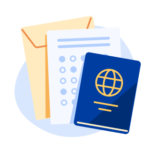The first year of living and studying abroad is often the hardest for international students. Not only are you living far from home, you need to deal with a lot of complicated paperwork and arrangements. And that’s before you even start your first class! Every situation is different, but there are some important things every international student needs to remember to include in their packing list for Canada. Bring the 10 items on our university study abroad checklist and video below, and you’ll be set up for an awesome first year of studies.
For guidance from application to arrival, try ApplyBoard’s free-to-use platform and find a program that fits your needs.
Watch our University Checklist video!
10. Funds for Living Expenses
The first item on our study abroad checklist is a place to live. Having accommodations secured before you land in Canada is essential. For one thing, you don’t want to be scrambling to find a place to live after your classes start. More importantly, border officers will often ask you about your accommodations and can turn you away if you don’t have a place to live. For this reason, it’s important you have your full accommodation information, including the address, when entering Canada.
You’ll also need to prove you have the financial means to support yourself while you study. As of January 1, 2024, all international students living in Canada must prove access to a minimum amount of C$20,635 for your living expenses. This is in addition to your tuition fees.
9. Funds for Tuition
As mentioned above, you’ll need to prove you can pay for your living expenses in addition to tuition costs. While studying in Canada is more affordable compared to other countries, tuition will still set you back anywhere from C$30,000 to C$50,000 a year.
If you’d like to pay for classes from outside of Canada, bank drafts or money orders (in Canadian dollars) are accepted by most universities and colleges.
Guaranteed Investment Certificates (GICs) can strengthen your study permit application by proving your financial means. Find out more about student GICs, and consider a trusted GIC from Canada’s largest bank!
8. Winter Clothes
You’ve likely heard that Canada gets really cold in the winters and, well, it’s the truth! In Toronto, which is actually one of Canada’s warmer cities in the winter, the average temperature in January is about -5.5°C (22°F) and it’s not uncommon to see the temperature drop to -20°C or more.
A winter coat, boots, hats, and gloves are a must in order to stay warm. However, if buying winter clothes is trickier in your home country, you can wait to buy things like boots and a warm winter coat until you get to Canada.
If you live in southern British Columbia, you may be able to not buy as many winter clothes, as this region doesn’t get as cold as the rest of Canada. However, if you’re studying anywhere else, you’ll need to bundle up!

7. Canadian Bank Account
One of the first things you should do after you get settled into your new home in Canada is open a Canadian bank account. Doing so will help you manage your money, and make it easier to collect income if you end up working in Canada. Opening an account may seem overwhelming at first, but it’s fairly easy to do. We recommend opening a no-fee chequing account. You may also want to find a bank that offers services in your native language if you’re still learning English or French.
Check out our step-by-step guide to opening a student bank account in Canada.

6. Tech and Gadgets
When it comes to tech and gadgets, some will be much more useful to your education than others. The most important piece of technology you’ll want to secure is a smartphone. Whether you bring a phone from home as part of your packing list for Canada, or purchase one once you arrive, you’ll need to use a Canadian mobile carrier during your stay. While Canadians pay some of the highest mobile fees in the world, there are many great deals available to students. We recommend shopping around and finding one that fits your budget.
Laptops are a great investment (and will make note-taking much easier) but they aren’t essential. If you’re bringing any electronics from home, you’ll want to make sure they are compatible with Canadian outlets and voltages. If not, you’ll need an adapter (or several, depending on how many electronics you have).

5. Emergency Contact List
For many international students, studying abroad will be the first time they’ve lived away from home. And, depending on where you’re from, you could be living far away from your family. For this reason, we’ve included emergency contacts in our study abroad checklist. It’s a good idea to share your list of emergency contacts with new friends and roommates if you have them. This list should include your parents or guardians, siblings, relatives, and anyone you know and trust who lives locally.
Make sure you have both physical and digital copies (you may want to email it to yourself) to avoid losing it.
Check out our four ideas to help you conquer homesickness when studying abroad.

4. Government ID
Next on our study abroad checklist is government ID. Your passport isn’t the only proof of identity you’ll need as an international student. While your passport will let you travel internationally, it’s a good idea to bring every piece of official ID you can, such as a driver’s license and birth certificate, as part of your packing list for Canada. (Make copies of all of these documents before you leave your home country, and leave them with your parents/guardians, or in a secure location.)
Also, you’ll want to ensure that your passport is valid for at least six (6) months past your date of arrival, and ideally for the full duration of your study period.

3. Insurance
Coming in at third place on our study abroad checklist is health insurance. All international students in Canada must have health insurance, so this item isn’t optional. In fact, universities and colleges will insist on it. While it may seem like an unnecessary cost, health insurance could save your finances (and your life) in the event of a medical emergency.
In some provinces and territories, international students may be eligible for provincial health care programs, where in others, you’ll need to buy private insurance. So, check with your institution to find out what’s required.
Looking for advice after you land in Canada? Check out our arrival guide to help simplify the process.
2. Medical Records and Prescriptions
Before you get insurance, you’ll need to make sure your medical records and prescriptions are in order. Depending on where you’re moving from, you may need to pass a medical exam before being allowed to enter Canada. Your school will outline which documents you’ll need to bring, including medical, dental, and vaccination records. Making sure your vaccinations are up-to-date (by Canadian standards) is also essential.
As part of our study abroad checklist, if you have any prescriptions, you’ll want to ensure you have enough to cover you when you arrive in Canada. There is a chance your medication won’t be available in Canada. If this is the case, do your research and see what your options are when you arrive in Canada. However, in other cases, you’ll be able to update your prescription with a local pharmacy quickly and easily.

1. Letter of Acceptance
The final item on our university checklist is your letter of acceptance (LOA). Your letter of acceptance is more than just your confirmation of enrolment at a Canadian school – it’s required to get your study permit. In order to attain your study permit, you’ll need to present your original acceptance letter to Citizenship and Immigration Canada (CIC). In other words, you need a printed copy of your original acceptance letter. Don’t forget it!
For more information on documents you’ll need for a Canadian student visa, check out our guide on what you’ll need to study in Canada.
We hope this packing list for Canada and study abroad checklist helped you prepare for your first year as an international student. Best of luck on your future adventures!
Ready to make the jump and study abroad? Create your free ApplyBoard account today!





